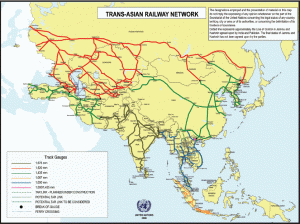Memo #200
By Jargalsaikhan Mendee – mendee [at] alumni.ubc.ca
 Broad gauge or standard gauge railway? This domestic Mongolian debate reflects Inner Asian ambivalence toward economic opportunities through engagement with China, as well as broader geopolitical and economic competition between Russia and China. After he was fired from the post of Director of the Mongolian Railway on January 10, former Prime Minister M. Enkhsaikhan criticized the government’s plan to extend the domestic broad (Russian) gauge railroad network. Instead, he argued for a 267 km standard (Chinese) gauge railroad from Tavan Tolgoi, a coal mining deposit, to Gashuun Sukhait, a Sino-Mongolian border post. With this argument Mr. Enkhsaikhan triggered another round of the debate over narrow vs. broad gauge.
Broad gauge or standard gauge railway? This domestic Mongolian debate reflects Inner Asian ambivalence toward economic opportunities through engagement with China, as well as broader geopolitical and economic competition between Russia and China. After he was fired from the post of Director of the Mongolian Railway on January 10, former Prime Minister M. Enkhsaikhan criticized the government’s plan to extend the domestic broad (Russian) gauge railroad network. Instead, he argued for a 267 km standard (Chinese) gauge railroad from Tavan Tolgoi, a coal mining deposit, to Gashuun Sukhait, a Sino-Mongolian border post. With this argument Mr. Enkhsaikhan triggered another round of the debate over narrow vs. broad gauge.
In 2010, the Mongolian parliament prioritized rail links connecting major mining sites in the south to the trans-Mongolian and Russian railways to reduce reliance on Chinese markets and to support the establishment of mineral processing factories for value added exports. Mining companies had been lobbying for direct narrow gauge links with the Chinese rail network to increase exports and to minimize environmental damage. The current coalition government formed following the parliamentary election in June 28, 2012, reaffirmed the 2010 decisions, emphasizing employment and development opportunities for Mongolia.
The gauge problem is not unique to Mongolia. Chinese plans to increase its land bridges over the vast Eurasian terrain also provoke debates within Central Asian states, especially Kazakhstan and Kyrgyzstan. Despite talk of building standard gauge rail through Kazakhstan linking China and Southeast Asia to Europe, Kazakhstan has chosen broad gauge for its latest rail connections with China. Kyrgyzstan, which offers a convenient transit route, prefers a broad gauge for an expected new rail link with China because of domestic gauge standards and bilateral arrangements with Russia. Thus any new railroad connections between China and Central Asian states require cross border transshipment facilities.
Gauge debates in Mongolia and Central Asian republics reflect their ambivalent attitudes to China, emphasizing economic benefits on one hand, but security concerns on the other. At the same time, the Sino-Russian geopolitical and economic competition cannot be overlooked in these landlocked Inner Asian states where Russia still maintains strong influence.
About the Author:
Jargalsaikhan Mendee is a PhD student in the Department of Political Science at the University of British Columbia, and an Institute of Asian Research Fellow, 2013.

Trans-Asian Railway Network
(Source: http://www.unescap.org/pdd/publications/survey2011/figures/index.asp)
Links:
- China-Kyrgyzstan-Uzbekistan Railway Project Brings Political Risks, Analyst, Central Asia-Caucasus Institute, March, 2012
- Second China – Kazakhstan Rail Link Inaugurated, Railway Gazette, December, 2012
- Temir Zholy Raises $300 mln More to Finance Rail-Road in Kazakhstan, Reuters, November, 2012


[…] Mongolia: Gauging Inner Asian Tensions over Railways – Заметка Ж. Мэндээ о проблеме железных дорог (широкая колея или стандартная). Поделиться:по электронной почтеПечатьFacebookTwitterGoogle +1 […]
[…] Asian Research Fellow, 2013. He has also authored Memo #11, Memo #87, Memo #161, Memo #169, Memo #200, & Memo […]